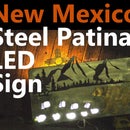Introduction: DIY Metal Chimney Cap for Historic Home
Here in Oklahoma City there are a lot of historic homes. This one was built in the 1920s and has been missing its original Chimney Cap for years.
Based on some ideas from the homeowner and a bit of research I came up with this design in Fusion 360 and then moved on to building.
The Chimney was also 3/8" out of square in two directions, meaning the entire structure had to be built to accommodate that offset.
Watch the build here:
Step 1: Cutting the Base
I used a CNC plasma cutter to cut out the base that everything else was built off, but the same outcome could be achieved with a grinder and some careful layout.
The downside of Plasma Cutting is that it leaves dross, or solidified metal on the edge of the cuts. This is easily taken care of with a grinder and Twisted Wire Cup.
Step 2: Making the Uprights
I used 2" square tubing with 14ga thick walls for the uprights. 14 gauge means that the sides of the tubes are about 1/15th of an inch thick, a great balance of weight and strength for this application.
The tubes were welded into their places in the previously made base piece, first by tacking them into place, then by welding out the joint fully.
Step 3: Fixing the Warp and Adding the Skirt
When welding on thin metal, you're VERY likely to warp it. In the previous step, the warping was pretty severe.
Luckily, the skirt pieces which meet that warped piece at a 90 degree angle can easily serve to straighten out the base piece. Just take your time to line things up.
Step 4: Adding the Faces
The faces were ALL different widths due to the out-of-square design.
After getting the base and skirt straight, I measured each face's width, then cut out these pieces with appropriately sized windows in each face on the Plasma Cutter.
Each face was tacked into place for the time being.
Step 5: Fixing the Top in Place
Due to the non-square nature of the design, I cut out the hypothetically correct top piece then made a few 1/8" minor adjustments to it with a grinder and diamond cut off/grinding wheel.
This wheel has abrasives on the edge like any cut off wheel, but also on the faces so you can "shape" pieces sideways with it, something that would normally make a cut off wheel shatter.
Step 6: Welding It Up!
After getting everything aligned, the process is basically to add a lot of tacks, or small welds. Fulling welding out each joint would be overkill and add a lot of potential for warping. As the strength of a full weld is not needed, the tacks are the way to go.
In the last picture you'll see that one tack is still hot while my intern is welding the opposite side. By alternating left to right in tacking, you further reduce the chances for warping.
Step 7: Grinding
Before adding the top skirt, we take a few minutes to grind everything now while more faces are easy to access. Between a 4.5" angle grinder and flap disk and a 2" Roloc stile die grinder, we made short work of cleaning up the faces.
Step 8: Top Skirt
After cleaning up the faces with our grinders, we added a top skirt made of 1.5" strips of 14ga steel (again) then ground those welds to make them pretty.
Step 9: Stainless Steel
As the fireplace at the base of the chimney is a small natural gas unit, there won't be a lot of heat to deal with, but directly above the small chimney pipe is likely to get the most heat so instead of covering the top of the Chimney Cap with mild steel, we used stainless steel so it wouldn't need paint and would resist heat without rusting.
This stainless steel cap was cut HOT on the table, intentionally giving it a warp so that rain will run off the Stainless Steel cap. The cap was screwed down to the chimney cap with 1/4" spacers so hot gases can escape around it.
Step 10: Window Frames
I used my cold cut saw to cut some 3/16"x1" flat bars to trim the windows in.
These were tacked into place from the front, then again from behind.
Step 11: Window Screens
In order to keep critters from getting into the chimney while still letting gases escape, we used Expanded Steel which is a diamond shaped mesh that is strong and good looking. To cut it, I again used the grinding/cut-off disc and a rule to mark my cuts.
These windows screens are tacked into place from behind.
Step 12: How to Attach It?
I again cut some 3/16"x1" flat bar at 45 degrees to make some attachment points in order to screw the Chimney Cap into the Chimney brick.
Watch the youtube video at
To see how quickly a cold cut saw can make a mess of a part.
After adding the screw downs, the Chimney cap was built and I sent it off for Powder Coating with a high temp resistant powder coat.
Step 13: Install
We dragged the chimney cap up to the top of this house and mounted it on the chimney (it was HEAVY). After screwing it down to the brick with TAPCON style masonry screws, the Chimney was Complete.
Thanks for stopping by!













